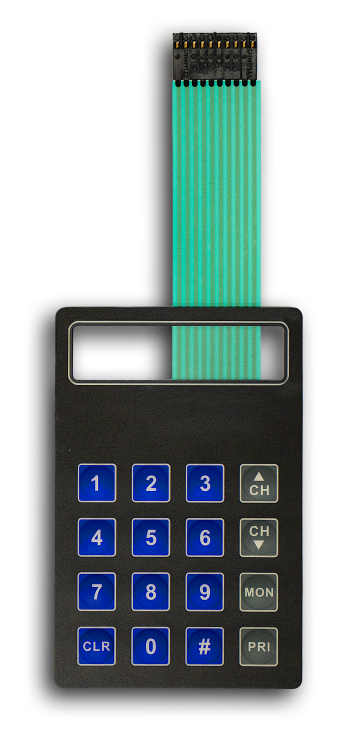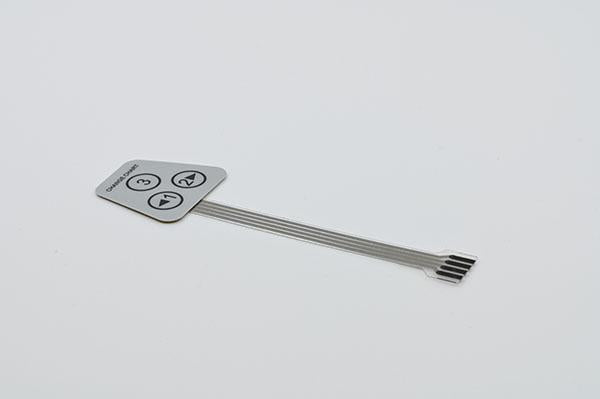How Membrane Switches Are Designed for Easy Maintenance and Repair
How Membrane Switches Are Designed for Easy Maintenance and Repair
Blog Article
Discover Just How Membrane Switches Function and Their Role in Modern Electronics
Membrane Switches represent a sophisticated assimilation of modern technology and design within the realm of contemporary electronic devices, functioning as necessary interfaces in numerous gadgets. Comprised of multiple layers, these switches make use of pressure-sensitive systems to help with customer interaction. Their applications span numerous industries, from customer electronic devices to clinical tools, highlighting their adaptability and relevance. Recognizing the ins and outs of Membrane switch functionality and their wider ramifications in enhancing individual experience invites additional exploration into their layout, advantages, and the cutting-edge developments forming their future in modern technology.
What Are Membrane Buttons?

Membrane switches are identified by their toughness and resistance to environmental variables, such as dust, dampness, and severe temperatures. They can be customized with numerous graphics, shades, and responsive responses alternatives, improving individual experience while maintaining aesthetic appeal - membrane switches. The unification of published circuits allows for smooth combination into devices, improving overall performance.
The adaptability of Membrane switches appears in their capability to support both basic and complicated control features. They can include features such as LED signs and touch-sensitive modern technology, satisfying particular user needs. As modern technology remains to advance, Membrane Switches remain essential for making it possible for reliable and user-friendly individual interfaces, thus playing a critical function in the improvement of modern-day electronic tools.
Parts of Membrane Buttons
Membrane buttons are composed of numerous crucial components that collaborate to develop a dependable and useful interface. The main components include the visuals overlay, adhesive layer, spacer layer, and conductive traces.
The graphic overlay serves as the customer interface, usually published on a versatile substratum such as polyester or polycarbonate. This layer not just offers visual appeal yet additionally includes tactile responses, visual signs, and protective attributes. Underneath the graphic overlay exists the sticky layer, which safeguards the switch to the gadget and guarantees sturdiness versus environmental anxieties.
The spacer layer is crucial for maintaining the necessary gap in between the visuals overlay and the circuit layer. This gap permits the activation of the switch when pressure is used. The conductive traces, usually made from silver or carbon, develop the electric pathways that finish the circuit when the button is engaged.
Additionally, a support layer may be included for structural assistance and insulation. These parts collaborate seamlessly, ensuring that Membrane switches are both easy to use and resilient, making them crucial in various modern electronic applications.
Just How Membrane Switches Job
Just how do Membrane Switches function efficiently within digital devices? Membrane Switches operate on the principles of pressure-sensitive technology, using a layered construction that includes visuals overlays, sticky layers, and conductive components. When an individual applies stress to over at this website the switch, the top layer flaws, enabling the conductive aspects below to make get in touch with and complete an electrical circuit. This activity sets off the preferred function within the tool.
The style of Membrane switches is essential for their reliable operation (membrane switches). The layers are meticulously crafted to supply tactile responses, toughness, and resistance to environmental aspects such as moisture and dust. The incorporation of domes-- tiny, increased locations within the button-- enhances tactile response, giving individuals with an obvious click feeling upon activation
Additionally, Membrane buttons can be personalized in regards to dimension, shape, and graphics, making them suitable for various applications. They are often utilized in control panels, clinical gadgets, and consumer electronic devices as a result of their smooth layout and integrity. Overall, the reliable functioning of Membrane switches is critical in boosting user interaction and guaranteeing seamless operation in contemporary digital devices.

Applications in Modern Gadgets
Utilizing their one-of-a-kind design and functionality, Membrane buttons have actually become essential elements in a wide variety of modern electronic devices. These functional interfaces are utilized in customer electronic devices, commercial equipment, medical gadgets, and automobile controls, supplying smooth customer communication.
In consumer electronics, Membrane buttons are commonly discovered in devices like microwaves, cleaning equipments, and various other house devices, where they allow user-friendly control with a smooth profile. Their inconspicuous style assists in combination into compact gadgets, improving aesthetic allure without jeopardizing functionality.
In industrial applications, Membrane Switches work as control panels for machinery, using try this web-site toughness and resistance to harsh settings. Their ability to endure dampness and impurities makes them suitable for usage in manufacturing and processing industries.
Clinical gadgets additionally gain from Membrane switches, which are made to be very easy to tidy and maintain, making certain hygiene in medical settings. They are usually utilized in diagnostic devices, client surveillance systems, and mobile medical gadgets, where dependability is extremely important.
Advantages of Membrane Buttons
Among the key advantages of Membrane buttons is their adaptability, which enables them to be tailored for a range of applications across several sectors. These buttons can be designed in numerous sizes and shapes, fitting one-of-a-kind product demands while providing smooth integration into devices. Their slim profile allows a portable and smooth layout, typically boosting the aesthetic allure of electronic items.
Another considerable advantage is their durability - membrane switches. Membrane buttons are generally immune to dust, dampness, and chemicals, making them perfect for extreme environments. This strength prolongs their life-span contrasted to conventional mechanical buttons, reducing the demand for frequent replacements
Furthermore, Membrane Switches deal cost-effectiveness. The manufacturing procedure entails printing technologies that reduce manufacturing costs, especially for huge runs. This price, combined with low official site upkeep needs, makes them an attractive option for producers.

Conclusion
In conclusion, Membrane Switches represent a significant development in individual interface technology within modern electronic devices. As the demand for durable and user-friendly interfaces proceeds to grow, the role of Membrane buttons in shaping user experience will certainly increase.
Membrane Switches represent a sophisticated assimilation of innovation and layout within the world of contemporary electronic devices, serving as important interfaces in various tools.In the realm of modern-day electronics, Membrane Switches serve as critical elements that promote user communication with devices. As modern technology proceeds to develop, Membrane Switches continue to be crucial for allowing instinctive and reliable user interfaces, consequently playing a pivotal function in the development of modern electronic tools.
How do Membrane Switches function efficiently within digital devices? In general, the efficient functioning of Membrane switches is essential in boosting individual interaction and guaranteeing smooth operation in contemporary electronic gadgets.
Report this page